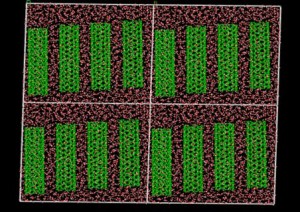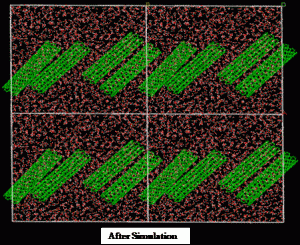Aggregation of particles is a ubiquitous phenomenon in mineral and material processing industries. Reagents adsorbed onto the surfaces of these particles can be used to prevent aggregation and assist in particle dispersion. Dispersion has beneficial applications in mineral processing, ceramics processing industries where the charge is kept dispersed (selectively or otherwise).
In some cases, dispersion is unavoidable and detrimental, i.e. in the tar-sand industry; micro-emulsion of water-in-oil droplets laden with solid particles poses a major handicap in the oil-recovery and increase the cost of its production. When particle sizes reach nanometer levels their tendencies to aggregate are stronger. This problem is further complicated by the lack of clear quantitative methodology to estimate the degree of dispersion of these particles due to different reagents.
Atomistic simulation techniques such as Molecular Dynamics (MD) offer an effective way of modeling and estimating the strength of reagent-particle interactions and their correlation with the dispersion. Consequently, two main objectives have been envisaged for this program. The first objective is to develop a correlation between dispersion and interaction energy of particle-reagent system. The second objective is to calculate transport properties such as viscosity, thermal conductivity etc..,. The above objectives will provide a direct means to evaluate and compare various reagents used in these studies through simple rheological experiments. A standard methodology for correlating the dispersion phenomena with interaction strength and reagent packing density would be established.
Furthermore, the study will aid in development of highly effective, novel dispersant for any given industrial condition, which can be tailored and developed at a very low cost. It is believed that the success in this program will significantly reduce the time spent in developing new reagents for industries such as ceramics processing, coating, polymer fillers, pharmaceuticals, health care, mineral processing, etc.


